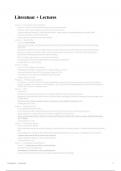OCD Study guides, Class notes & Summaries
Looking for the best study guides, study notes and summaries about OCD? On this page you'll find 4626 study documents about OCD.
Page 3 out of 4.626 results
Sort by
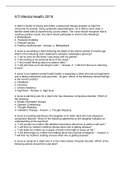
-
ATI Mental Health 2019 Questions And Answers
- Exam (elaborations) • 14 pages • 2023
-
Available in package deal
-
- $12.49
- 4x sold
- + learn more
A client is fearful of driving and enters a behavioral therapy program to help him overcome his anxiety. Using systematic desensitization, he is able to drive down a familiar street without experiencing a panic attack. The nurse should recognize that to continue positive results, the client should participate in which of the following? a. Biofeedback b. Therapist modeling c. Frequent pacing d. Positive reinforcement - Answer- a. Biofeedback A nurse is counseling a client following the ...
Alle hoorcolleges aantekeningen, alle artikelen samengevat per lecture en antwoorden op de learning objectives .
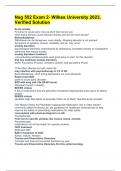
-
Nsg 552 Exam 2- Wilkes University 2023, Verified Solution
- Exam (elaborations) • 6 pages • 2023
-
- $9.99
- 3x sold
- + learn more
Nsg 552 Exam 2- Wilkes University 2023, Verified Solution Acute anxiety First line for acute panic may be short term benzo use. short acting benzos cause rebound anxiety and are the most abused Benzodiazepines Withdrawal can be dangerous, even deadly. Stopping abruptly is not advised. Symptoms of agitation, tension, irritability, and sz. may occur anxiety disorders psychological disorders characterized by distressing, persistent anxiety or maladaptive behaviors that reduce anxiety anxi...
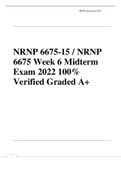
-
NRNP 6675-15; NRNP 6675 Week 6 Midterm Exam 2022/23 100% solved -Graded A+
- Exam (elaborations) • 32 pages • 2023
-
- $17.99
- 4x sold
- + learn more
NRNP 6675-15; NRNP 6675 Week 6 Midterm Exam 2022 100% solved -Graded A+ NRNP 6675-15; NRNP 6675 Week 6 Midterm Exam 2022 100% solved -Graded A+ 1. Which of the following are risk factors for neuroleptic malignant syndrome? Select all that apply Age Rapid dose escalation Parental route of administration Higher potency typical antipsychotics 2. Antipsychotic medications provide D2 blockade in the mesocortical pathway causing which of the following effects? Reduces negative symptoms Increases e...
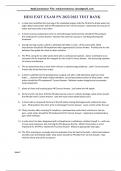
-
HESI EXIT EXAM PN TEST BANK QUESTIONS AND ANSWERS, 100% Verified & A+ Graded
- Exam (elaborations) • 23 pages • 2023
-
- $14.99
- 2x sold
- + learn more
HESI EXIT EXAM PN TEST BANK QUESTIONS AND ANSWERS, 100% Verified & A+ Graded 1. a male client admitted the morning of his scheduled surgery tells the PN that he drank water last night. What intervention will the PN implement first? Correct Answer: Determine the amount of water and exact time it was taken 2. A client receives ondansetron prior to chemotherapy treatment.How should the PN evaluate this medication? Correct Answer: Monitor the client for nausea or vomiting following the treatment 3. ...
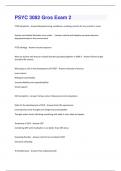
-
PSYC 3082 Gros Exam 2 Already Passed!!
- Exam (elaborations) • 6 pages • 2024
- Available in package deal
-
- $8.39
- 1x sold
- + learn more
PTSD symptoms - Answer-Reexperiencing, avoidance, numbing, persists for one month or more Anxiety and related disorders occur when : - Answer-natural and adaptive processes become disproportionate to the environment PTSD etiology - Answer-trauma exposure Why are trauma and stressor related disorders grouped together in DSM-5 - Answer-Shared origin (stressful life events) What plays a role in the development of PTSD? - Answer-Intensity of trauma Learn alarms Biological vulnerability Unco...

-
ATI MENTAL HEALTH TEST BANK EXAM COMPLETE QUESTIONS AND CORRECT DETAILED ANSWERS (VERIFIED ANSWERS) |ALREADY GRADED A+
- Exam (elaborations) • 36 pages • 2023
- Available in package deal
-
- $13.99
- 1x sold
- + learn more
ATI MENTAL HEALTH TEST BANK EXAM COMPLETE QUESTIONS AND CORRECT DETAILED ANSWERS (VERIFIED ANSWERS) |ALREADY GRADED A+ schizo client returns to facility hallucinating and unkempt, nurse assessment should focus on - ANSWER- physical needs (appearance/behavior could be because of physical injury or fluid/electrolyte imbalance client taking triclyclic antidepressants with what symptom should be immediately brought to dr attention - ANSWER- urinary retention (serious side effect that c...

-
NR 546 Midterm Exam Questions and Answers Latest Update 2023/2024
- Exam (elaborations) • 55 pages • 2023
-
- $17.99
- 1x sold
- + learn more
NR 546 Midterm Exam Chlorpromazine Thiazide & Pimozide Aripiprazole Correct! Clozapine & Olanzapine Question 2 2 / 2 pts The PMHNP has prescribed chlorpromazine hydrochloride (Thorazine) for a patient with psychosis, and the patient is to continue on the oral medication after discharge from the psychiatric unit. As part of educating the patient about the medication, the PMHNP should advise him or her to avoid: exercise. Correct! sun expos...
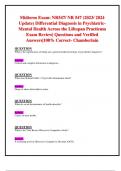
-
Midterm Exam: NR547/ NR 547 (2023/ 2024 Update) Differential Diagnosis in PsychiatricMental Health Across the Lifespan Practicum Exam Review| Questions and Verified Answers|100% Correct- Chamberlain
- Exam (elaborations) • 13 pages • 2023
-
Available in package deal
-
- $10.49
- 1x sold
- + learn more
Midterm Exam: NR547/ NR 547 (2023/ 2024 Update) Differential Diagnosis in PsychiatricMental Health Across the Lifespan Practicum Exam Review| Questions and Verified Answers|100% Correct- Chamberlain QUESTION What is the significance of ruling out a general medical etiology in psychiatric diagnosis? Answer: Critical and complex distinction in diagnosis. QUESTION What does Boland Table 1-23 provide information about? Answer: Drugs of abuse detectable in urine. ...

-
Purple Book NBCOT, Complete Answered Rationales Test Bank 2022.
- Exam (elaborations) • 251 pages • 2023
-
- $13.99
- 2x sold
- + learn more
Purple Book NBCOT, Complete Answered Rationales Test Bank 2022. An OT is preparing to evaluate a toddler who has UE orthopedic concerns. How will the OT MOST likely obtain the majority of the initial assessment data? a. measurement tools that assess visual-motor skills. b. dynamometer and pinch meter readings. c. Observation of a child during activities in the child-care center. d. Functional independence measures. -Answer- C. observation of a child during activities in the child-care ce...

How much did you already spend on Stuvia? Imagine there are plenty more of you out there paying for study notes, but this time YOU are the seller. Ka-ching! Discover all about earning on Stuvia

